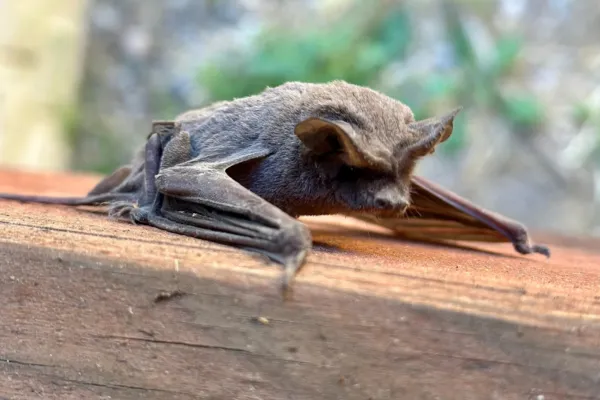
BLOGS
BLOG

The Hidden Dangers of a Bat Infestation: What Every Homeowner Needs to Know
You’re lying in bed at night, and suddenly you hear it — a faint fluttering or scratching in the walls or ceiling. At first, you brush it off as nothing. Mice? The wind? But as the days passed, you notice droppings in the attic, a strange smell, or even a glimpse of wings darting through the night sky. That’s when it hits you: You might have bats in your home.
Before you panic, let’s clear one thing up — bats aren’t out to get you. In fact, they’re vital for the ecosystem, eating thousands of insects each night (hello, mosquito control!). But when bats decide to set up camp inside your home, they quickly go from helpful wildlife to serious household pests.
Let’s dive into the real risks of a bat infestation and how you can safely and effectively deal with it — with a little help from your local experts at Valley Wide Pest Control.
First Things First: How Do Bats Get In?
Bats are sneaky. They can squeeze into holes as small as a dime, making it incredibly easy for them to enter homes through vents, chimneys, cracked rooflines, or tiny gaps in siding. They especially love quiet, dark areas like attics, eaves, and wall voids—basically, any spot you don’t check often.
Once they’re in, they’re not quick to leave. Bats are creatures of habit, and if your home offers a safe place to roost, they’ll keep coming back.
The Real Dangers of a Bat Infestation
Sure, bats flying around your attic might sound like a Halloween movie plot, but the truth is much less fun. Here are the real issues homeowners face:
1. Health Hazards from Guano (Bat Droppings)
Bat droppings, known as guano, may seem harmless at first. But over time, guano builds up — and that’s where the danger begins.
Guano can grow a fungus called Histoplasma capsulatum, which causes a serious lung disease called histoplasmosis. The spores become airborne, especially when disturbed, and breathing them in can lead to chronic coughing, chest pain, and flu-like symptoms. It’s especially dangerous for kids, seniors, or anyone with a weakened immune system.
2. Risk of Rabies and Bites
While not all bats carry rabies, bats are the #1 cause of rabies transmission to humans in the U.S. Most of the time, bats won’t attack people, but if one gets trapped inside your living space and feels threatened, it might bite in self-defense. Even if you don’t notice a bite, contact with a bat should always be taken seriously.
3. Structural Damage
Bats don’t chew wires or wood like rodents, but they cause other types of damage. Their guano and urine are highly acidic and can corrode wood, drywall, insulation, and even metal over time. A long-term infestation can ruin your attic and cause serious repair bills.
4. Horrible Smells and Noises
Let’s not forget the smell. Bat guano has a strong ammonia-like odor, especially when it accumulates. That stink doesn’t stay put in your attic either—it seeps through insulation and drywall, spreading into your living space. If you’ve ever walked into a room and caught a sudden whiff of something like old urine or mildew, it could be bats overhead.
And the noise? Constant squeaking, fluttering, and scratching—mostly at dusk and dawn—can drive anyone up the wall (literally). If you’re hearing odd nighttime sounds, don’t assume it’s just the wind.
5. Legal Trouble (Yes, Really)
Here’s a curveball: Many bat species are protected by federal and state laws. That means you can’t legally trap or kill them, and you’re not allowed to evict them during certain times of the year (like maternity season when baby bats can’t fly yet). Accidentally harming or disturbing a protected species could lead to fines or legal issues.
Trying to handle it yourself—especially during the wrong season—can get messy fast.
Why Does DIY Bat Removal Usually Fail?
We get it—when something’s living rent-free in your attic, your first instinct is to get it out yourself. But with bats, DIY is rarely a good idea.
Here’s why:
You could trap bats inside by sealing off exits too early.
You might unknowingly expose yourself to histoplasmosis or rabies.
You could harm a protected species and face penalties.
Most over-the-counter repellents and gadgets don’t work.
Bottom line: this isn’t a job for Google and a flashlight.
How Valley Wide Pest Control Can Help
That’s where Valley Wide Pest Control comes in—we’ve got the tools, experience, and know-how to handle bat infestations the right way.
Free, Thorough Inspections
We start with a full inspection of your home, including the attic, vents, eaves, and roofline. We look for signs of bat activity, locate entry points, and assess any damage or guano buildup.
Humane Bat Exclusion
Using specialized one-way exit devices (that are totally bat-friendly), we allow bats to leave—but not come back. Once we’re sure they’re all out, we seal up every crack and crevice to stop future invasions.
Cleanup & Sanitization
Bat guano isn’t just gross—it’s dangerous. We safely remove the waste, clean contaminated surfaces, and deodorize the area. If insulation needs replacing, we can handle that too.
Licensed & Legal
We work within local and federal wildlife protection laws, so you can rest easy knowing everything’s done by the book. No surprises. No drama.
Peace of Mind
You’ll be back to enjoying your home without those unsettling noises, smells, or health worries. And we don’t just fix the problem—we help prevent it from ever coming back.
Don’t Let Bats Take Over Your Home
A bat infestation isn’t just a quirky wildlife problem—it’s a serious health and safety issue that can snowball quickly if ignored. From disease risks to expensive home repairs, the consequences are too big to brush off.
If you’ve noticed strange noises at night, droppings in the attic, or even a bat flying through your house—don’t wait.
Call Valley Wide Pest Control Today
We’re your local bat removal experts, and we’re here to help you reclaim your home—safely, legally, and effectively.
👉 Call us now for a free inspection or book online to get started.
With Valley Wide Pest Control, you don’t just get pest control—you get peace of mind.
© 2024 Valley Wide Pest Control. All rights reserved.

